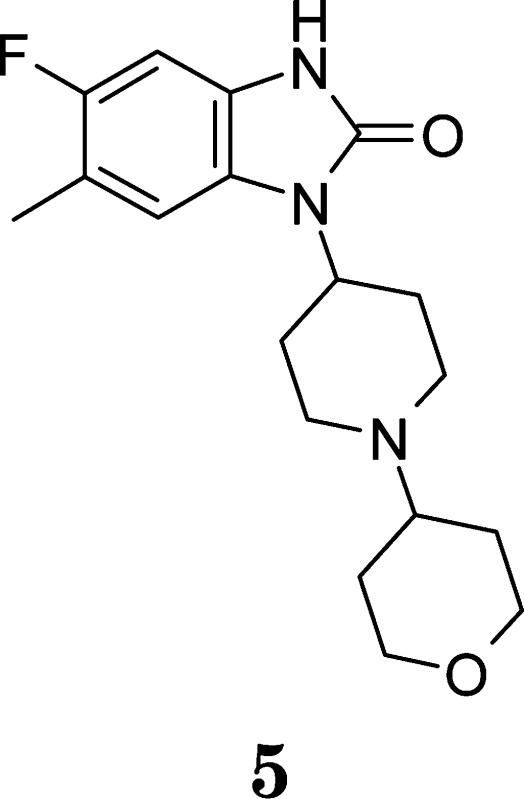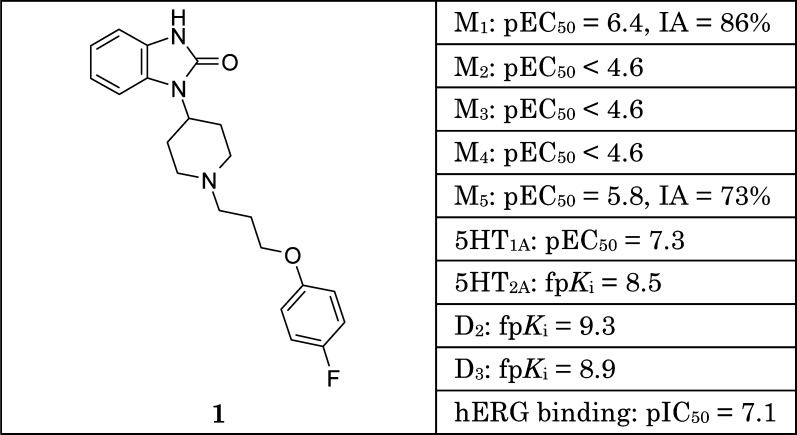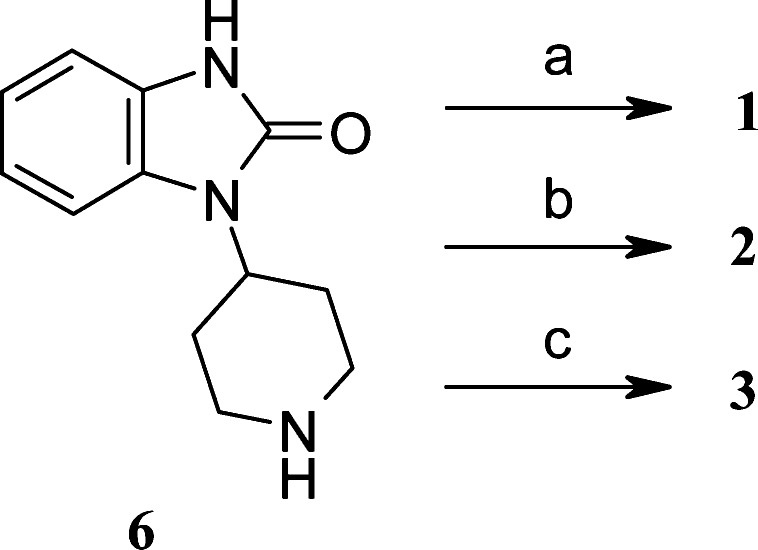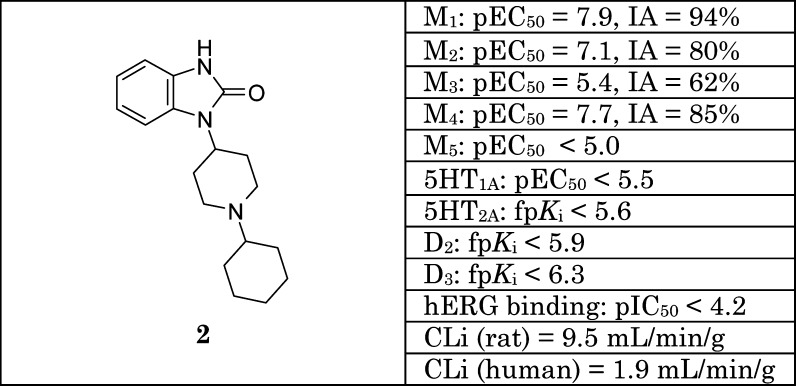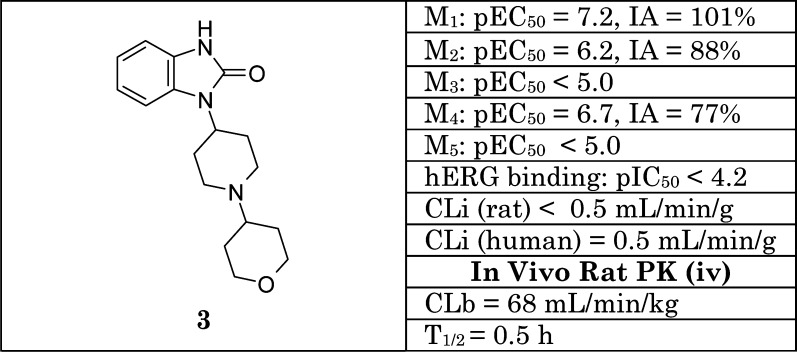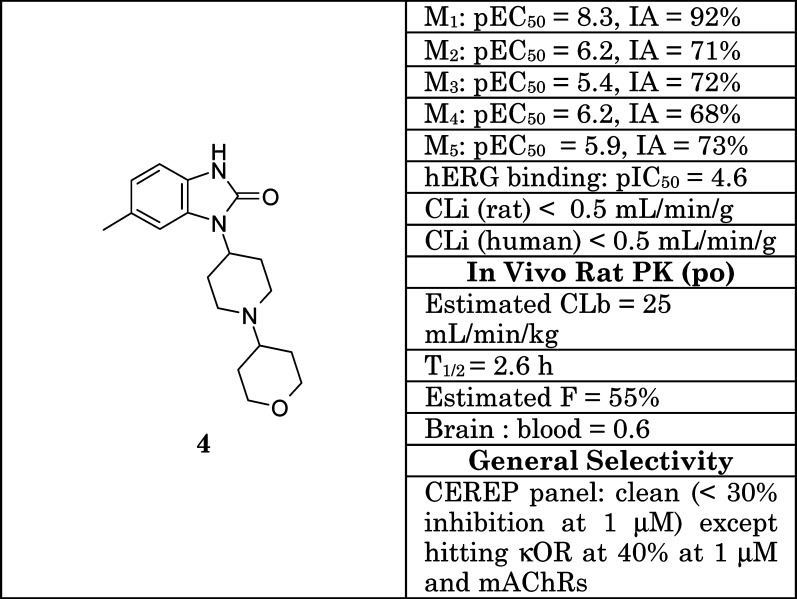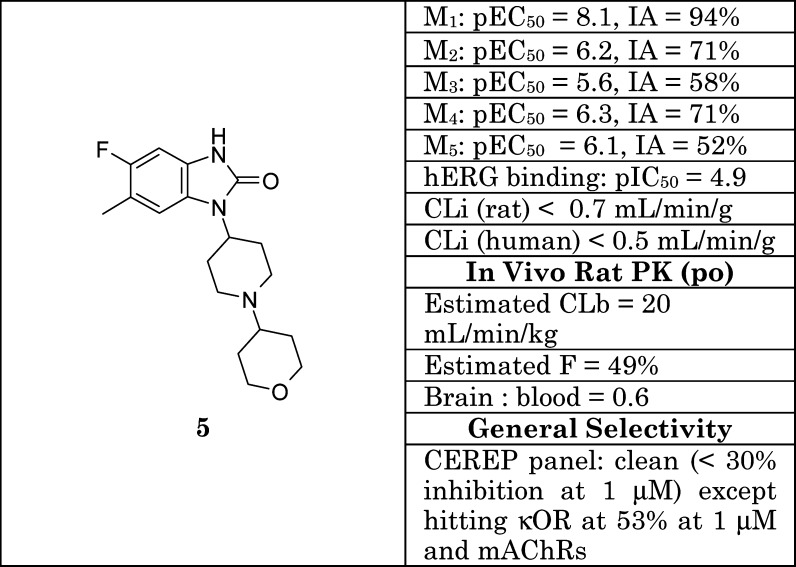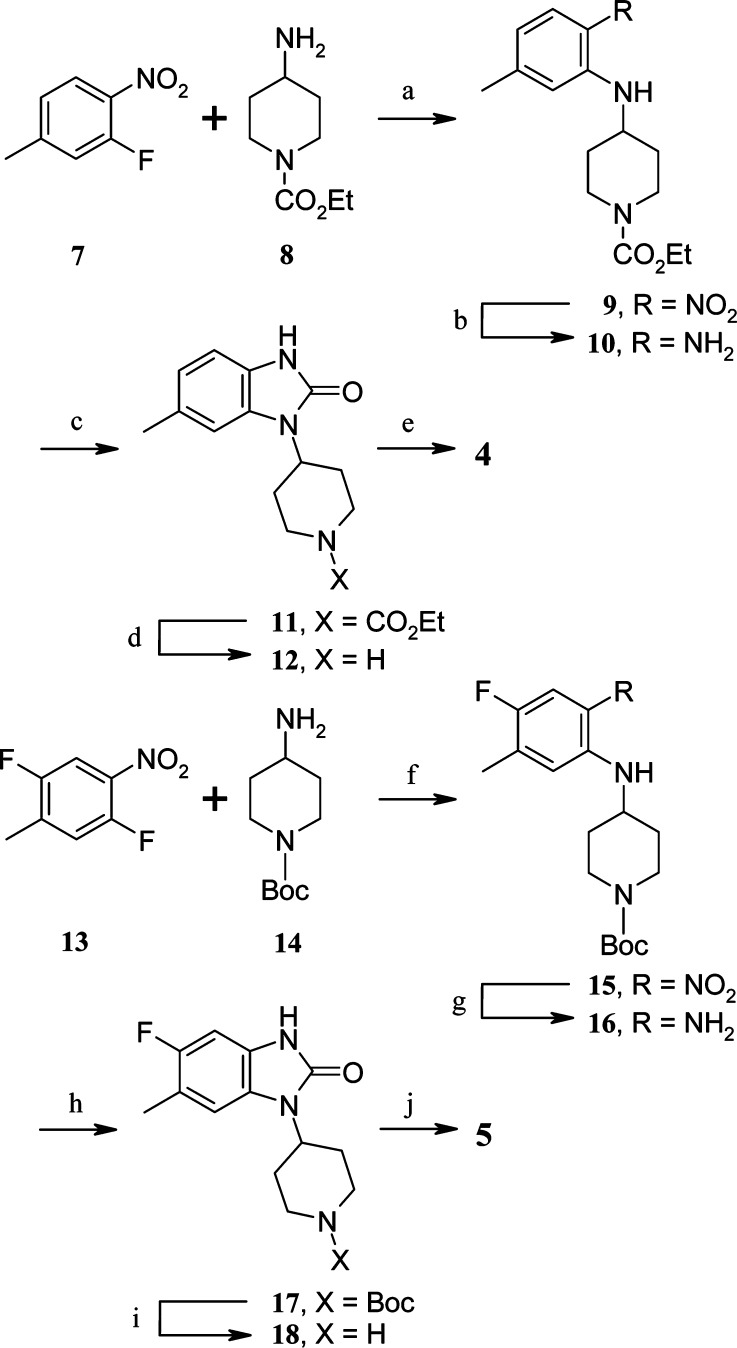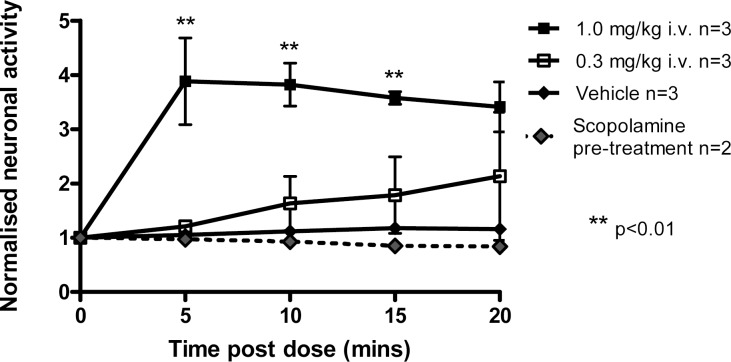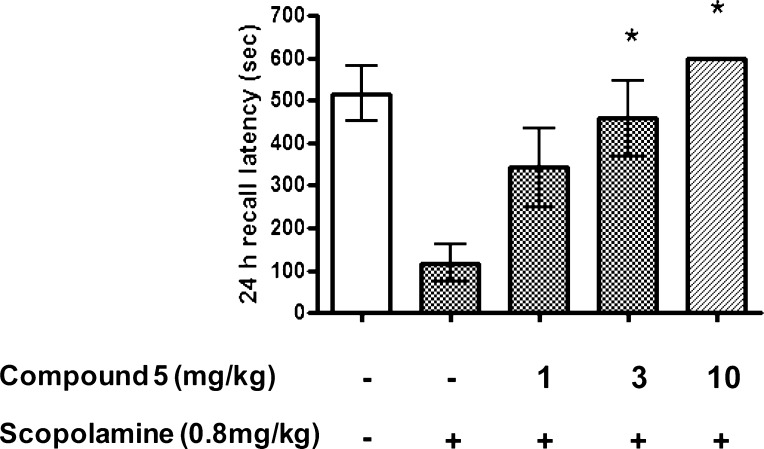Abstract
Virtual screening of the corporate compound collection yielded compound 1 as a subtype selective muscarinic M1 receptor agonist hit. Initial optimization of the N-capping group of the central piperidine ring resulted in compounds 2 and 3 with significantly improved potency and selectivity. Subsequent optimization of substituents on the phenyl ring of the benzimidazolone moiety led to the discovery of novel muscarinic M1 receptor agonists 4 and 5 with excellent potency, general and subtype selectivity, and pharmacokinetic (PK) properties including good central nervous system (CNS) penetration and oral bioavailability. Compound 5 showed robust in vivo activities in animal models of cognition enhancement. The combination of high potency, excellent selectivity, and good PK properties makes compounds 4 and 5 valuable tool compounds for investigating and validating potential therapeutic benefits resulting from selective M1 activation.
Keywords: M1 muscarinic acetylcholine receptor, M1 mAChR, CNS-penetrant and orally active M1 mAChR agonists, subtype selective, benzimidazolones, 1-(N-substituted piperidin-4-yl)benzimidazolones
The muscarinic acetylcholine receptors (mAChRs) belong to the seven-transmembrane receptors (7TMRs, also known as G-protein coupled receptors (GPCRs)) family A and are activated by their native ligand neurotransmitter acetylcholine.1−4 Five muscarinic mAChR subtypes, M1−M5, are known to date.2−4 M1−M5 mAChRs are widely distributed in mammalian organs and the central and peripheral nerve system where they mediate important neuronal and autocrine functions including memory and attention mechanisms, motor control, and nociception.5,6 In particular, selective M1 agonism has been suggested as a therapeutic approach in dementia including Alzheimer’s disease and age-associated memory impairment or cognitive impairment associated with schizophrenia.7 Furthermore, recent clinical results from pan mAChR agonists have resulted in severe GI and CV side effects that further demonstrate the need for selective M1 agonists.8,9 In addition, the activation of M1 mAChR has been reported to play a role in protecting neurons from apoptosis induced by oxidative stress.10 However, M1−M5 mAChRs share a common orthosteric ligand-binding site with an extremely high sequence homology, which explains why it has been difficult historically to identify subtype selective ligands.4
Recently, an allosteric binding site unique to M1 mAChR has been identified.11,12 This breakthrough led to the discovery of AC-42, the first subtype selective M1 agonist, which achieved the high degree of subtype selectivity via binding to this unique allosteric binding site.11,12 A number of subtype selective M1 agonists were subsequently reported including TBPB and its analogues13−15 and our 2′ biaryl amides.16,17 In this letter, we describe the identification, synthesis, and evaluation of a series of novel 1-(N-substituted piperidin-4-yl)benzimidazolones, which were first disclosed in our published patent applications,18,19 in a number of in vitro and in vivo biological and pharmacokinetic (PK) studies. Optimization of this benzimidazolone series resulted in the discovery of compounds 4 and 5 as potent, selective, central nervous system (CNS)-penetrant, and orally active M1 mAChR agonists.
Virtual screening of the corporate compound collection against the allosteric binding site11,12 of M1 mAChR using an M1 mAChR homology model, which was built on the basis of the crystal structure of bovine rhodopsin,20 yielded about 1000 putative hits. Evaluation of these compounds in our human M1 fluorometric imaging plate reader (FLIPR) assay, which measures compound induced Ca2+ mobilization in Chinese hamster ovary (CHO) cells that stably expressed human M1 mAChR, led to the identification of compound 1 as an M1 mAChR agonist with moderate potency21 (Figure 1). Compound 1 was subsequently evaluated in M2−M5 FLIPR assays and found to have good subtype selectivity for M1 over M2−M4 and modest subtype selectivity for M1 over M5. It is worth noting that compound 1 was also identified as a hit via high throughput screening (HTS) of the corporate compound collection that was carried out later. It was gratifying that both hit generation approaches (virtual screening and HTS) yielded several common hits such as compound 1 and the virtual screening strategy provided our drug discovery program a tractable hit ahead of the HTS campaign. However, compound 1 showed high affinity to a number of aminergic 7TMRs including 5HT1A, 5HT2A, D2, and D3 (Figure 1). In addition, compound 1 had high binding affinity to hERG (the human Ether-a-go-go Related Gene). To improve potency and selectivity and reduce the potential hERG liability, we initially focused our medicinal chemistry effort on optimizing the N-capping group of the central piperidine ring of compound 1.
Figure 1.
Virtual screening hit 1.
Compounds with various N-capping groups were synthesized from commercially available 1-(piperidin-4-yl)benzimidazolone (6) (Scheme 1). Alkylation of 6 with 1-chloro-3-(p-fluorophenoxy)propane under microwave heating conditions afforded compound 1. Reductive alkylation of 6 with cyclohexanone or 4-tetrahydropyranone yielded compounds 2 and 3 respectively.
Scheme 1. Synthesis of Compounds 1, 2, and 3.
(a) 1-Chloro-3-(p-fluorophenoxy)propane, KI, DIEA, CH3CN, μW 210 °C, 2 min, 56%; (b) cyclohexanone, Na(OAc)3BH, AcOH, DCE, rt, 16 h, 44%; (c) 4-tetrahydropyranone, Na(OAc)3BH, AcOH, DCE, rt, 16 h, 42%.
Initial optimization of the right-hand-side N-capping group of compound 1 led to the discovery of compound 2, which possesses a cyclohexyl group instead of the floppy 3-(4-fluorophenoxy)propoxy group in compound 1. Compound 2 was a significantly higher potency M1 mAChR agonist than compound 1 (Figure 2). In addition, compound 2 showed excellent selectivity for M1 over M3, M5, 5HT1A, 5HT2A, D2, and D3 in a very significant improvement over compound 1. In hERG binding assay, compound 2 showed drastic improvement (about 1000-fold) over compound 1. However, compound 2 suffered from poor selectivity for M1 over M2 and M4. Additionally, in in vitro metabolic stability studies using rat and human liver microsomes, compound 2 had high intrinsic clearance (CLi) for rat and moderate CLi for human.
Figure 2.
Profile of compound 2.
To improve metabolic stability of this series, the cyclohexyl ring of compound 2 was replaced with the tetrahydropyran (THP) group in compound 3. This modification resulted in improved in vitro metabolic stability (CLi ≤ 0.5 mL/min/g for both rat and human) while maintaining good M1 mAChR agonist activity, good selectivity for M1 over M3 and M5, and good hERG profile. However, selectivity for M1 over M2 and M4 was not improved. In addition, in an in vivo rat PK study, compound 3 showed high in vivo clearance (CLb = 68 mL/min/kg) and short half-life (T1/2 = 0.5 h) after intravenous (iv) administration at 1 mg/kg (Figure 3).
Figure 3.
Profile of compound 3.
To improve subtype selectivity for M1 over M2 and M4 and in vivo rat PK properties of this series, we explored substituents on the phenyl ring of the benzimidazolone moiety. Optimization of this region led to the discovery of compounds 4 and 5. Compound 4 that contains a 6-methyl group on the benzimidazolone ring had excellent M1 mAChR agonist activity (pEC50 = 8.3) and selectivity against all 4 subtypes (>100-fold selective for M1 over M2−M5) (Figure 4). Compound 4 also had good in vitro metabolic stability versus rat and human liver microsomes and was >5,000-fold selective for M1 mAChR over hERG channel. Importantly, in an in vivo rat PK study, compound 4 appeared to show significantly reduced in vivo clearance (estimated CLb = 25 mL/min/kg)22 and moderate half-life (T1/2 = 2.6 h), oral bioavailability (estimated F = 55%),22 and CNS penetration (brain/blood ratio = 0.6) after oral (po) administration at 3 mg/kg. To assess general selectivity, compound 4 was evaluated in the CEREP selectivity panel, which consists of a broad range of 7TMRs (or GPCRs), ion channels, and transporters, and found to be clean (less than 30% inhibitions at 1 μM) against all targets in the panel except hitting κ-opioid receptor (κOR) at 40% inhibition at 1 μM and, as expected, the mAChRs in the panel.
Figure 4.
Profile of compound 4.
Similar to compound 4, compound 5, which has a 5-fluoro-6-methyl benzimidazolone moiety at the left-hand side, potently activated M1 mAChR, had excellent subtype and general selectivity, and possessed good in vitro and in vivo PK properties (Figure 5). The combination of these excellent properties makes compounds 4 and 5 outstanding tool compounds for in vivo animal studies.
Figure 5.
Profile of compound 5.
Synthesis of compounds 4 and 5 is outlined in Scheme 2. Aromatic nucleophilic substitution of aryl fluoride 7 with protected 4-aminopiperidine 8 yielded nitroaniline 9, which was quantitatively hydrogenated to 10. Benzimidazolone formation via CDI gave 11, followed by quantitative deprotection of the ethyl carbamate by alkaline hydrolysis to give 12. Reductive alkylation of 12 with 4-tetrahydropyranone furnished compound 4. Analogous steps for the synthesis of compound 5 began with aryl fluoride 13 undergoing displacement with N-Boc-4-aminopiperidine 14 to give nitroaniline 15, which was reduced via transfer hydrogenation with Raney nickel and hydrazine to afford 16 which was cyclized by CDI to yield benzimidazolone 17. Boc deprotection to 18 followed by Ti(O-i-Pr)4 facilitated reductive alkylation with 4-tetrahydropyranone produced compound 5.
Scheme 2. Synthesis of Compounds 4 and 5.
(a) KI, Na2CO3, DMF, 50 °C, 15 h, 84%; (b) H2, 5% Pd/C, MeOH, 100%; (c) N,N′-carbonyldiimidazole (CDI), CH3CN, 40 °C, 36 h, 76%; (d) 2.5 M aqueous NaOH, reflux 15 h, 100%; (e) 4-tetrahydropyranone, Na(OAc)3BH, AcOH, DCE, rt, 16 h, 51%; (f) DIEA, DMF, 80 °C, 38 h, 64%; (g) Raney nickel, N2H2·H2O, EtOH, 45 °C, 50 min, 92%; (h) CDI, THF, 45 °C, 80 min, 77%; (i) 20% TFA/DCM, 1 h, rt, 94%; (j) 4-tetrahydropyranone, Ti(O-i-Pr)4, MeOH, 1.5 h, then NaBH3CN, 1.5 h, 42%.
The effects of compound 5 on cell firing rate in the CA1 region of the rat hippocampus were evaluated next. Intravenous administration of 5 (1 mg/kg) significantly enhanced cell firing rate in the hippocampal CA1 region (Figure 6). Over a 3-fold enhancement (P < 0.01, repeated measures ANOVA) of neuronal activity was observed. A lower dose of 5 (0.3 mg/kg, iv) failed to produce a significant increase in cell firing rate. Pretreatment of the mAChR antagonist scopolamine (3 mg/kg, ip) 15 min prior to the iv administration of 5 (1 mg/kg) abolished the enhancement in cell firing rate induced by 5. These studies confirmed that compound 5 activated native mAchRs in vivo.
Figure 6.
Effect of iv administration of compound 5 on cell firing rate in the CA1 region of the rat hippocampus.
In addition, compound 5 was evaluated in a passive avoidance rat model to assess its ability of enhancing cognition and memory. As shown in Figure 7, scopolamine rendered the animals amnesic in the passive avoidance task (P < 0.05 cf. vehicle treated controls). Oral administration of compound 5 reversed the scopolamine-induced amnesia in a dose-dependent manner with significant effects observed following 3 and 10 mg/kg doses (P < 0.05 cf. scopolamine in both cases). Taken together, these results suggest that selective M1 mAChR agonists such as compound 5 are effective cognition enhancers and could provide a potentially valuable treatment option for schizophrenia.
Figure 7.
Effect of oral administration of compound 5 on scopolamine-induced amnesia in rats.
In conclusion, a series of novel 1-(N-substituted piperidin-4-yl)benzimidazolones was identified as M1 mAChR agonists via virtual screening. Optimization of this benzimidazolone series resulted in the discovery of compounds 4 and 5 as potent, CNS-penetrant, orally active M1 mAChR agonists with excellent subtype and general selectivity. Compound 5 significantly enhanced cell firing rate in rat hippocampal CA1 region and reversed the scopolamine-induced amnesia in a dose-dependent manner, demonstrating robust in vivo efficacy in preclinical schizophrenia models. The combination of outstanding potency, excellent selectivity, and good PK properties makes these compounds valuable tools for the biomedical research community to further investigate and validate potential therapeutic benefits resulting from selective M1 agonism.
Acknowledgments
We thank Minghui Wang and Bing Wang for NMR, Bill Leavens for HRMS, and Andrew Foley and Claire Barry for in vivo passive avoidance support.
Abbreviations
mAChRs, muscarinic acetylcholine receptors; 7TMRs, seven-transmembrane receptors; GPCRs, G-protein coupled receptors; PK, pharmacokinetic; CNS, central nervous system; FLIPR, fluorometric imaging plate reader; CHO cells, Chinese hamster ovary cells; HTS, high throughput screening; hERG, the human Ether-a-go-go Related Gene; IA, intrinsic activity; fpKi, functional pKi; CLi, intrinsic clearance; THP, tetrahydropyran; κOR, κ-opioid receptor.
Supporting Information Available
Synthetic procedures and characterization data for all compounds. Procedures for human M1−M5 FLIPR assays. Protocols for in vivo rat hippocampal CA1 cell firing and passive avoidance experiments. fpKi overview. This material is available free of charge via the Internet at http://pubs.acs.org.
These authors contributed equally to this work.
Supplementary Material
References
- Fredriksson R.; Lagerstrom M. C.; Lundin L. G.; Schioth H. B. The G-protein-coupled receptors in the human genome form five main families. Phylogenetic analysis, paralogon groups, and fingerprints. Mol. Pharmacol. 2003, 63, 1256–1272. [DOI] [PubMed] [Google Scholar]
- Caulfield M. P.; Birdsall N. J. International Union of Pharmacology. XVII. Classification of muscarinic acetylcholine receptors. Pharmacol. Rev. 1998, 50, 279–290. [PubMed] [Google Scholar]
- Eglen R. M. Muscarinic receptor subtype pharmacology and physiology. Prog. Med. Chem. 2005, 43, 105–136. [DOI] [PubMed] [Google Scholar]
- Hulme E. C.; Birdsall N. J.; Buckley N. J. Muscarinic receptor subtypes. Annu. Rev. Pharmacol. Toxicol. 1990, 30, 633–673. [DOI] [PubMed] [Google Scholar]
- Caulfield M. P. Muscarinic receptors—characterization, coupling and function. Pharmacol. Ther. 1993, 58, 319–379. [DOI] [PubMed] [Google Scholar]
- Eglen R. M. Muscarinic receptor subtypes in neuronal and non-neuronal cholinergic function. Auton. Autacoid Pharmacol. 2006, 26, 219–233. [DOI] [PubMed] [Google Scholar]
- Fisher A.; Pittel Z.; Haring R.; Bar-Ner N.; Kliger-Spatz M.; Natan N.; Egozi I.; Sonego H.; Marcovitch I.; Brandeis R. M1 muscarinic agonists can modulate some of the hallmarks in Alzheimer’s disease: implications in future therapy. J. Mol. Neurosci. 2003, 20, 349–356. [DOI] [PubMed] [Google Scholar]
- Heinrich J. N.; Butera J. A.; Carrick T.; Kramer A.; Kowal D.; Lock T.; Marquis K. L.; Pausch M. H.; Popiolek M.; Sun S. C.; Tseng E.; Uveges A. J.; Mayer S. C. Pharmacological comparison of muscarinic ligands: historical versus more recent muscarinic M1-preferring receptor agonists. Eur. J. Pharmacol. 2009, 605, 53–56. [DOI] [PubMed] [Google Scholar]
- Mirza N. R.; Peters D.; Sparks R. G. Xanomeline and the antipsychotic potential of muscarinic receptor subtype selective agonists. CNS Drug Rev. 2003, 9, 159–186. [DOI] [PMC free article] [PubMed] [Google Scholar]
- Giordano G.; Li L.; White C. C.; Farin F. M.; Wilkerson H. W.; Kavanagh T. J.; Costa L. G. Muscarinic receptors prevent oxidative stress-mediated apoptosis induced by domoic acid in mouse cerebellar granule cells. J. Neurochem. 2009, 109, 525–538. [DOI] [PMC free article] [PubMed] [Google Scholar]
- Spalding T. A.; Trotter C.; Skjaerbaek N.; Messier T. L.; Currier E. A.; Burstein E. S.; Li D.; Hacksell U.; Brann M. R. Discovery of an ectopic activation site on the M1 muscarinic receptor. Mol. Pharmacol. 2002, 61, 1297–1302. [DOI] [PubMed] [Google Scholar]
- Langmead C. J.; Fry V. A.; Forbes I. T.; Branch C. L.; Christopoulos A.; Wood M. D.; Herdon H. J. Probing the molecular mechanism of interaction between 4-n-butyl-1-[4-(2-methylphenyl)-4-oxo-1-butyl]-piperidine (AC-42) and the muscarinic M1 receptor: direct pharmacological evidence that AC-42 is an allosteric agonist. Mol. Pharmacol. 2006, 69, 236–246. [DOI] [PubMed] [Google Scholar]
- Jones C. K.; Brady A. E.; Davis A. A.; Xiang Z.; Bubser M.; Tantawy M. N.; Kane A. S.; Bridges T. M.; Kennedy J. P.; Bradley S. R.; Peterson T. E.; Ansari M. S.; Baldwin R. M.; Kessler R. M.; Deutch A. Y.; Lah J. J.; Levey A. I.; Lindsley C. W.; Conn P. J. Novel selective allosteric activator of the M1 muscarinic acetylcholine receptor regulates amyloid processing and produces antipsychotic-like activity in rats. J. Neurosci. 2008, 28, 10422–10433. [DOI] [PMC free article] [PubMed] [Google Scholar]
- Bridges T. M.; Brady A. E.; Kennedy J. P.; Daniels R. N.; Miller N. R.; Kim K.; Breininger M. L.; Gentry P. R.; Brogan J. T.; Jones C. K.; Conn P. J.; Lindsley C. W. Synthesis and SAR of analogues of the M1 allosteric agonist TBPB. Part I: Exploration of alternative benzyl and privileged structure moieties. Bioorg. Med. Chem. Lett. 2008, 18, 5439–5442. [DOI] [PMC free article] [PubMed] [Google Scholar]
- Miller N. R.; Daniels R. N.; Bridges T. M.; Brady A. E.; Conn P. J.; Lindsley C. W. Synthesis and SAR of analogs of the M1 allosteric agonist TBPB. Part II: Amides, sulfonamides and ureas—the effect of capping the distal basic piperidine nitrogen. Bioorg. Med. Chem. Lett. 2008, 18, 5443–5447. [DOI] [PMC free article] [PubMed] [Google Scholar]
- Budzik B.; Garzya V.; Shi D.; Foley J. J.; Rivero R. A.; Langmead C. L.; Watson J.; Wu Z.; Forbes I. T.; Jin J.. 2′ Biaryl amides as novel and subtype selective M1 agonists. Part I: Identification, synthesis, and initial SAR. Bioorg. Med. Chem. Lett. 2010, 20, 3540−3544. [DOI] [PubMed] [Google Scholar]
- Budzik B.; Garzya V.; Shi D.; Walker G.; Lauchart Y.; Lucas A. J.; Rivero R. A.; Langmead C. L.; Watson J.; Wu Z.; Forbes I. T.; Jin J.. 2′ Biaryl amides as novel and subtype selective M1 agonists. Part II: Further optimization and profiling. Bioorg. Med. Chem. Lett. 2010, 20, 3545−3549. [DOI] [PubMed] [Google Scholar]
- Budzik B.; Cooper D. G.; Forbes I. F.; Jin J.; Shi D.; Smith P. W.; Walker G.. Benzimidazolones which have activity at M1 receptor. 2007, WO 036711.
- Budzik B.; Cooper D. G.; Forbes I. F.; Garzya V.; Jin J.; Shi D.; Smith P. W.; Walker G.. Compounds which have activity at M1 receptor and their uses in medicine. 2007, WO 036718.
- Palczewski K.; Kumasaka T.; Hori T.; Behnke C. A.; Motoshima H.; Fox B. A.; Le Trong I.; Teller D. C.; Okada T.; Stenkamp R. E.; Yamamoto M.; Miyano M. Crystal structure of rhodopsin: A G protein-coupled receptor. Science 2000, 289, 739–745. [DOI] [PubMed] [Google Scholar]
- The biological assay results in this paper are a mean of at least 2 determinations with standard deviation of <±0.3 unless otherwise noted.
- Drug concentrations in hepatic porter vein and cardiac blood samples at various time points were measured and used to estimate in vivo clearance and oral bioavailability of test compounds.
Associated Data
This section collects any data citations, data availability statements, or supplementary materials included in this article.



